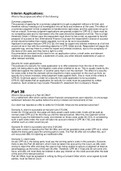Interim Applications:
What is the purpose and e ect of the following:
Summary judgments:
The purpose of applying for a summary judgment is to get a judgment without a full trial, and
therefore without needing a full investigation into all facts and evidence of the case. The e ect of
a summary judgment is that a judgment is handed down right away, and the case does not go to
trial as a result. Summary judgment applications are granted subject to CPR 42.2; there must be
no compelling case and no real reason why the case should be disposed of at trial. This is a high
threshold; Swain v Hillman says the respondent must show he has a real, as opposed to fanciful
prospect of success at trial. International Finance Corp says the respondent’s chance of success
at trial should be better than merely arguable, but not so far as to be probable.
Applicant must argue that per CPR 24.2 (b), the need for expert and witness evidence at a full trial
would not be in line with the overriding objective in CPR 1(2)(b) and (d). Respondent will argue the
opposite way, and say there is a need for expert and witness evidence, due to the complexity of
the facts of the case, and they have a right to a trial
Documentation provided would need to be: an application notice, a draft order, and relevant
evidence (a witness statement, a statement of costs, any other relevant statements of case or
other relevant exhibits).
Security for costs applications:
The purpose of a security for costs application is to o er protection from the risk of the other
party not being able to pay the litigation costs when ordered to do so. This is usually made by the
defendant against the claimant, or another party that is not the claimant. The e ect of a security
for costs order is that the claimant will be required to make a payment to the court up front, as
security for a future monetary order/judgment made against them. One or more of the criteria in
CPR 25.13 (2)must apply in order for a security for costs application to be successful.
CPR 25.12(2) states that an application for security for costs must be supported by written
evidence. Such evidence may include; Precedent H, statement from Company’s House
Part 36
What is the purpose of a Part 36 O er?
It is a settlement o er which carries certain nancial consequences upon rejection, to encourage
settlement between the parties before the end (or indeed commencement) of trial.
Our client has rejected an o er to settle for £100,000. What are the potential outcomes?
Scenario A: client is successful at trial and wins £75,000.
Under 36.17(1)(a) and (3), the judge will likely award a split costs order. Costs will be paid as
normal under CPR 44.2 for the time up until the relevant period. After this, the Claimant will be
required to pay the Defendant’s costs, and interest on those costs under 36.17(3). In considering
such a split costs order, the court will take into account criteria in CPR 36.17(5), and decide
whether such an order would be just.
Scenario B: client is successful and wins £125,000
ABL were correct in rejecting the Part 36 O er, and will be awarded costs under CPR 44.2, which
states the losing party pays the winning party’s costs. The Part 36 o er will not a ect this, as it
will not punish ABL for rejecting an insu cient o er.
Scenario C: client loses
As per CPR 44.2, the losing party must pay the winning party’s costs in this scenario. However,
there is also the Part 36 element, which must be taken into account by the Court, as ABL were
wrong to reject the o er and drag the case to trial, being unable to secure a judgment at least as
advantageous as the terms of the part 36 o er. Therefore, CPR 36.17(1)(a) and (3) will come into
force, and ABL will most likely be ordered to also pay interest on the costs accrued after the date
of the end of the relevant period.
Part 36 O ers must be accepted in writing by ling a Consent Order which, once signed by both
parties, must be led at Court.
ff fi ff ff ffff ff ffi fffffi fi ff ff ff ff ff ff




